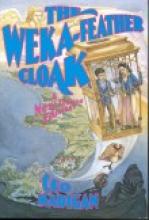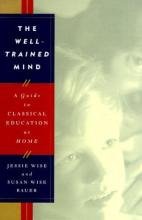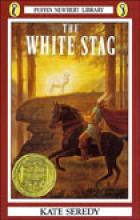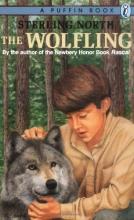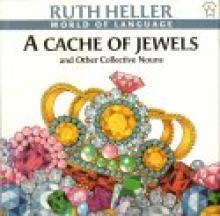No name
The Weka-Feather Cloak
Now for a little of the plot.... Danny Mago is a small, quiet 16 year old who is mercilessly picked on by his schoolmates, but recognized by his teachers as having remarkable artistic abilities. Knowing that his widowed mother is struggling to financially support Danny and his handicapped sister Angela, the deputy headmistress of his school offers him a job helping out on the grounds of the nun's convent and working as artistic assistant to Mother Madeleine, a renowned local artist. In cleaning up and cutting back overgrown portions of the convent grounds, Danny discovers an ancient elevator through which he visits some interesting historical characters. Soon he becomes involved in a contest to plan a backdrop to the altar of the new cathedral and a strange Turkish girl searching for an ancient painting of Our Lord (the Mandylion - rhymes with pavilion, not dandylion). Throw in an ancient Maori cloak and some mysterious trips courtesy of his guardian angel, and the result is a rather enjoyable, occasionally hair-raising, adventure story in a Catholic framework with a New Zealand setting. (There are interesting artistic sub-themes as well.) The author has included a glossary of New Zealand terms and an overview of some of the religious references. My two year old highly enjoys just hearing the words in the glossary which sound very funny to her - aniwaniwa, kohekohe, tiki, etc.
The author has a humorous writing style that should be appealing to modern readers. Leo Madigan, who has also authored a number of books about Fatima, skillfully interweaves a Catholic way of looking at things, but never at the expense of a good story. I especially like the sub-plot concerning Danny's sister Angela, who is seriously disabled. Her relationship with Danny is beautifully portrayed (they communicate with each other using their own system of sign-language, he confides in her during difficult times). Also, unlike a number of stories with crippled heroes who are cured in the end (like If All the Swords in England and The Hidden Treasure of Glaston), Angela's part of the story wraps up happily even though she is not completely cured of her malady. I appreciate this unique angle, especially for those who are dealing with such difficulties every day for the rest of their lives. There wouldn't be much hope for these much-beloved souls if happiness depended on a miraculous physical cure.
I hope you and your children (best for ages 12 and up) enjoy the story as much as I did.
This title was donated for review by Bethlehem Books
The Well-Trained Mind
Jessie Wise started homeschooling her daughter (and co-author Susan Wise Bauer) in 1973. In this book they elaborate ideas and resources for a complete classical curriculum from preschool through high school. From a Catholic standpoint, I think this book would be most useful for those who are already using Designing Your Own Classical Curriculum, but looking for additional ideas. I found the explanations of the stages of the Trivium very helpful as well as some of the ideas for types of writing assignments, lists of subject material and tidbits on scheduling and record-keeping. I also found the order in which certain materials are to be studied (particularly for History which they recommend studying in chronological fashion starting in first grade) to be more to my liking than the order proposed in Designing Your Own Classical Curriculum because I'd like to have my children studying the same topic in History at the same time. The authors had some important things to say about the problems with television and I really enjoyed (as a bit of a vindication of my own educational ideas I suppose) the story about Dr. Seuss and why he wrote The Cat in the Hat.
I would be reluctant to give this book to a mother who is already feeling overwhelmed with homeschooling or one who has just pulled her children out of a conventional school and is beginning to homeschool later in the game. Although it is not intended to be, I think it might be intimidating at this stage. Although the authors (who are not Catholic) don't fall into a number of "traps" regarding the Catholic Church that one might expect (as is clear from their segment on Religion), some of the resources (especially with regards to History) contain biases against the Catholic Church and should be used only with caution. A great deal of their recommended materials are those recommended by Greenleaf Press and/or published by Dorling Kindersley - I use materials from both of these sources, but many should be approached with caution if not avoided altogether.
I have not read the book in its entirety yet (I finished the Grammar segment and skimmed the rest). Overall, I found it worthwhile reading, but not "required reading", and some things should be taken with a grain of salt.
You can find out more about the book at the Well Trained Mind website run by co-author Susan Wise Bauer.
The White Stag
The two sons do in fact lead the people west following a mysterious white stag which seems to be leading them along. They find a good land and stay there many years but it is not the land that was foretold. While in this land, Hunor and Magyar capture and marry fairy "moonmaidens." Hunor and his wife have a son named Bendeguz, The White Eagle. Among the people a slight rift appears and some become more attached to fierce Hunor and his son and others to the more gentle Magyar. The entire tribe moves on, however, and as they leave Asia and move into Europe, they become more fierce. The are in constant battle with the people of the lands they pass and end up a plundering, warring tribe. Finally they find a place to build a stronghold between the Volga and Don Rivers. Here Bendeguz marries a woman from the peoples they have conquered and Attila is born. The tribe then splits and Bendeguz, with Attila and his followers, move further west while Magyar and his followers stay. The Huns fight on and on with Attila as their leader and become the most feared people in the west. The story ends with the fulfillment of the prophecy, the finding of the promised land, and Attila leading a festival in thanksgiving to the great god Hadur.
This story could not be considered a history of the Huns, but might be read as a supplement to a study of the times. It is as the Greek myths are to the history of the Greeks and sheds light on the religion and traditions of the ancient Huns. It is poetically and lovingly written and full of beautiful illustrations. Since it is somewhat short in length, ( 95 pages of which 39 are full page illustrations), it can be read fairly quickly.
Recommended for grade 4+
Newbery Medal Winner
The Winged Watchman
Note: If having your children "believe in Santa Claus" is important to you, there is a chapter which should be approached with caution.
Click here for Discussion Questions
The Winged Watchman (audio)
Throughout the book in fact, they, as well as their parents, are faced with choices, choices that involve risks, even death. Should they help the young girl left lying on the side of the road, the airman hiding in the mill, the man escaping from deportation? The risks they face are very real as they soon find out when their neighbor and his son, the same age as Joris, are taken away after British airmen are found hiding in his barn. As Joris stares at his classmate's empty desk in school, he is reminded all too vividly that his neighbor could be him.
Who is it that could have done such a wicked thing as to reveal the airmen's presence? It could be none other that Leendert Schenderhans, another neighbor boy, only not just a "boy" but a young man of eighteen, who had become a landwatcher, a Dutchman who enforces the laws of the Nazi occupation.
He too plays a critical part in the story. Joris has to only observe how he acts to realize that he does not want to be like him, cruel, selfish, lazy, and greedy. The reader doesn't have to be told he is mean, through his actions, we become all too keenly aware of his lack of virtue. More than just a nasty person, he is a person to be feared, because of his power.
Not just another story about WWII, this is a story every child should read or hear, because it not only offers children a very real view of history, but it also explores timeless issues they have to deal with every day, even today. How can I forgive my enemy?
This is a theme that is repeated throughout the story. Especially memorable is the scene when Joris comments that he thought he would get holes in his knees from praying for so many people. The story goes on to say, "At first she [mother] would not pray for the Germans, though Father said that was wrong. 'We have to pray for our enemies,' he said. 'What sort of Christian are you?' So then Mother prayed for the Germans too."
You won't be disappointed! This is a story to treasure, made especially enjoyable by a wonderful narrator, who makes this an absolute listening pleasure.
Click here for Discussion Questions Click here to listen to an audio sample on the Bethlehem Books website
Unabridged audio book, approximately 4 hours, 3 tapes or 4 CDs
Click here for Discussion Questions
The Wolfling
Wolfling is the follow up to Sterling North's Newbery Honor book Rascal. The two are loosely related in that they both take place in the wilderness of Wisconsin. Rascal is largely an autobiography of North's unusual childhood in Wisconsin in the early part of the 20th century while Wolfling takes place in the time that North's father was a boy soon after the Civil War. It is based on the letters that he sent North about his childhood.
The bottom line of the story is that the main character, Robbie, must figure out who he is, and what he wants to do with his life. He comes to discover this through his relationships with both virtuous and morally suspect people who live in his town, and through his relationship with his mother and father, who are going through a similar discernment. Robbie learns how to deal with the morally suspect characters without condoning their actions, while emulating the virtuous characters. His parents are portrayed are virtuous, hard working people who must deal with the hardships of life on the frontier, the hardest of which is the loss of several children. Robbie makes virtuous choices, and in that, the book is a good choice for young adolescents.
North weaves actual historical events and real historical characters into the story and in some ways this is the most interesting part of the story. He spends a good deal of time introducing the reader to Thure Kumlein, a Swedish naturalist who is largely unknown, but made great contributions in natural history research at the time. If I lived in Wisconsin I would be seeking out his works and trying to travel to the part of Wisconsin where this story takes place.
In the back of the book, North gives scientific and historical information about the events described in the story. He describes the Panic of 1873 and the great Chicago fire as adeptly as he describes the habits of wolves in that region. Speaking of wolves, you might wonder why this review doesn't mention the wolfling so far. The dog is important as a plot device to move the story of Robbie's coming of age, but he is not central to the story. However, your more subtle readers may see an analogy between the wolfling and Robbie. The wolfling straddles two worlds, the wild and the tame, just as Robbie straddles much the same two worlds, the "wild" unruliness of the frontier, and the "tame" of schooling and civilization.
I couldn't help comparing this book to North's more widely acclaimed Rascal, and I like this one much better. In Rascal, North spends a lot of time "teaching" about his evolutionary and social philosophies. I had decided my children shouldn't read it until they were older, even though they would love all the outdoor exploits of the main character. I think that Wolfling is a better story with a better message. And, the best part as far as my children are concerned is that Robbie doesn't have to give up the wolfling in the end.
The Wonderful Day
The World of Language Series
This series of six books introduces young children to concepts of grammar through very entertaining and sometimes humorous poetry and extremely colorful pictures. The titles are: Kites Sail High: A Book About Verbs, Behind the Mask: A Book About Prepositions,A Cache of Jewels and Other Collective Nouns, Merry-Go-Round: A Book About Nouns, Many Luscious Lollipops: A Book About Adjectives and Up, Up, and Away: A Book About Adverbs. Within the context of a fast-moving collection of widely-varying and very colorful illustrations, these poems explain, list and give examples of each of the parts of speech. For example, in the book Behind the Mask, you'll find the following sentences (emphasis is the same here as it is in the text) " Of PREPOSITIONS have no fear. They help to make directions clear. Along the northern shore bear east... beyond this green, reptilian beast... past its hungry, gaping mouth... veer directly... to the south, toward a place where mermaids flock upon, beside and near a rock." These particular sentences are spread out over six pages which include pictures of an antique-looking map illustrated with ships, a treasure chest, a Tritan, etc., a large pictures of a green serpent and a page full of mermaids. My children have really enjoyed these books and I have to admit that they are a decent refresher course for moms as well.
Unfortunately, almost every book has something (usually only one thing in each book) of a possibly-objectionable nature, such as: some scantily-clad mermaids and illustrations of witches (although appropriately portrayed as ugly and scary). The series is also recommended by Seton Home Study in their online reading resource lists.
The World of the Trapp Family
This in-depth history of the Trapp family (shortened from "von Trapp" when they became American citizens) begins with young Captain Georg von Trapp - a highly-decorated hero of the Austrian Navy during World War I. He and his wife Agathe (whose grandfather invented the torpedo) had just started a family a few years before the war broke out in 1914. The happy couple had seven children - Rupert, Agathe, Maria, Werner, Hedwig, Johanna and Martina - before Agathe's untimely death of scarlet fever in 1922.
Maria Kutschera was a twenty-two year old postulant at Nonnberg Abbey when her Mother Superior assigned her to become a teacher for one of the von Trapp children who was too sickly to attend school. The Captain and Maria were married within the year and Maria gave birth to three more children: Rosmarie, Eleanore and Johannes. Although there was a certain amount of musical talent in the family to begin with, Maria introduced to the family to a great variety of beautiful music (sacred music, traditional folk songs, etc.). Music became a big part of their lives and something that knit the family together very tightly.
After the family fortune was lost (1932) in events leading up to World War II, the family took boarders into their home in order to simply be able to keep their home. Because of these events, they became acquainted with a young priest, Fr. Franz Wasner in 1935. Fr. Wasner was a canon lawyer and musician who became interested in the family's musical talent and eventually became their musical mentor, conductor and composer who emigrated with them to America during the difficulties of World War II. He introduced them to an even greater variety of great vocal music and individual family members became skilled with the recorder and other instruments as well. Reluctantly, they began to accept invitations to sing before audiences and eventually came to realize that this was part of God's plan for them.
After the Nazi's took over Austria in 1938, the family had to turn down three separate propositions from the enemy: Captain von Trapp was offered the command of a German submarine, the eldest son - who was just barely out of medical school - was offered the post as head of one of the great Vienna hospitals, and the family choir was invited to sing for Hitler's birthday celebration. Each of these offered possibilities of fame and fortune, but the family felt that these would also compromise their basic obligations to God and country. Leaving behind their large estate and nearly all of their belongings, they traveled to America where they were invited to give an extensive concert tour.
The story continues to follow the von Trapp family as they make their way through the War years (with two sons fighting for the U.S.), become American citizens, tour as a choir for twenty years, establish themselves and a farm on a lovely site in Vermont and many other events all the way up to recent photos of the six children who are still alive today.
The book is brimming with hundreds of glossy photos (black and white of older family photos, color of beautiful scenes from Austria and America and more recent pictures) that are a real feast for the eyes. Their lives were so intertwined with significant parts of history, music and culture that this book - along with Maria Trapp's autobiography - could make an interesting supplement to a study of the 20th century. The beauty of the Catholic culture lived fully by the Trapp family through music, traditions, celebrations of Catholic faith and other aspects of their lives will make this especially enjoyed by Catholic families of today.
Donated for review by the author, William Anderson.

